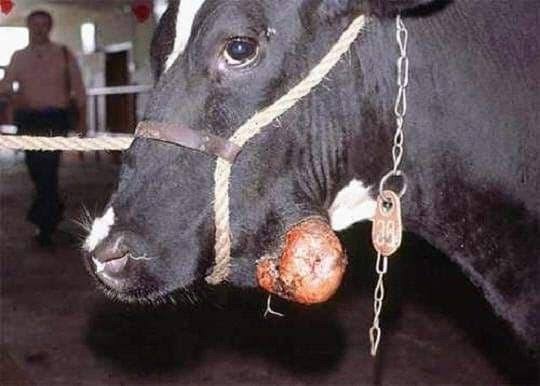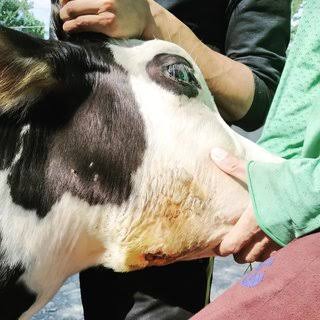Actinomycosis, also known as lumpy jaw, is a type of bacterial infection caused by Actinomyces bacteria, these bacteria are commonly found in the mouth, throat, and digestive tract of humans and animals. Actinomycosis usually occurs when these bacteria invade tissues, leading to the development of painful lumps or abscesses.
The scientific name for the bacteria responsible for Actinomycosis is Actinomyces. Despite its complex name, understanding this condition in simple terms is crucial. Imagine Actinomyces as tiny troublemakers that usually reside harmlessly in our mouths and digestive systems. However, when circumstances allow, these troublemakers can turn into more aggressive troublemakers, causing problems like lumpy jaw.
Lumpy jaw gets its name from the characteristic swelling it creates in the affected area, often around the jaw. This swelling occurs as a result of the body’s attempt to contain and fight the bacterial infection. So, in simple terms, lumpy jaw is like a protective response gone awry – the body’s effort to defend itself against Actinomyces ends up causing visible lumps.
The symptoms of Actinomycosis are not always straightforward. People or animals affected may experience pain, swelling, and the formation of pus-filled abscesses. It’s like a small war happening inside the body, with the bacterial invaders triggering the body’s defenses and causing these uncomfortable symptoms.
Actinomycosis can affect various parts of the body, not just the jaw. It might involve the lungs, abdomen, or other areas. The infection can spread slowly, creating a network of tunnels or fistulas that connect the affected regions. Picture these tunnels as hidden pathways where the bacteria travel, making it challenging for the body to completely eliminate them.
Diagnosing Actinomycosis may require medical professionals to take samples or perform imaging tests. Treatment typically involves antibiotics to target and eliminate the Actinomyces bacteria. Think of antibiotics as the superheroes that come to rescue the body from these troublesome bacteria, helping to bring an end to the infection.
Actinomycosis is a bacterial infection caused by Actinomyces, which usually live peacefully in our mouths and digestive systems. When things go awry, these bacteria can lead to lumpy jaw or other complications. It’s like a tiny battle inside the body, where antibiotics act as superheroes to defeat the troublemaking bacteria and restore order.
Read Also: Principles of Feeding Rabbit and Feed Resources
Animals Affected by Actinomycosis (Actinomyces)

Actinomycosis can affect a variety of animals, both domestic and wild. While humans are susceptible to this bacterial infection, animals can also fall victim to Actinomyces. Domestic animals, such as cattle, horses, sheep, and dogs, are commonly affected by Actinomycosis. In these animals, lumpy jaw is a frequent manifestation of the infection, causing noticeable swelling around the jaw area.
Cattle, in particular, are known to be prone to Actinomycosis, and the infection can spread among herds. This can be a concern for farmers as it may impact the overall health of their livestock.
Horses, too, can be affected, with symptoms resembling those seen in other animals. Swelling, abscess formation, and discomfort can be observed in the jaw or other parts of the body.
Additionally, Actinomycosis has been reported in small ruminants such as sheep and goats. Though less common than in cattle, these animals can still be affected, leading to similar symptoms of swelling and abscess formation.
Among companion animals, dogs may also experience Actinomycosis. While not as prevalent as in larger livestock, dogs can develop lumpy jaw or other localized infections caused by Actinomyces bacteria.
In the wild, certain wildlife species can also be susceptible to Actinomycosis. This bacterial infection does not discriminate between domestic and wild animals, underscoring the importance of understanding and managing the condition in various ecosystems.
In essence, Actinomycosis is not exclusive to humans; it can affect a range of animals, from farm livestock like cattle and horses to companion animals like dogs. Recognizing the potential impact on both domestic and wild species is crucial for effective management and prevention.
Damages Caused by Actinomycosis

Actinomycosis can cause various damages depending on the affected area and the severity of the infection. The primary damage is the formation of abscesses and tissue swelling, often leading to noticeable lumps, particularly around the jaw. These abscesses can be painful and may interfere with the normal functioning of the affected body part.
In cases of lumpy jaw, the bony structures of the jaw can be damaged as the infection progresses. The swelling and abscess formation can erode the bone, causing deformities and affecting the overall structure of the jaw. This damage can be a significant concern, especially in livestock like cattle, as it can impact their ability to eat and, consequently, their overall health.
Actinomycosis can also lead to the formation of fistulas or tunnels connecting the affected areas. These tunnels can create complications as they provide pathways for the infection to spread, making it challenging to completely eliminate the bacteria. The formation of these channels can complicate treatment and contribute to the persistence of the infection.
Moreover, if the infection is not promptly diagnosed and treated, Actinomycosis has the potential to spread to other parts of the body. For instance, it may affect the lungs, causing pneumonia-like symptoms. This spread of infection can result in systemic issues, affecting the overall health of the individual.
Damages caused by Actinomycosis include the formation of painful abscesses, erosion of bone structures (especially in cases of lumpy jaw), and the creation of fistulas that can complicate treatment. If left untreated, the infection can spread to other areas, leading to systemic complications and impacting the overall well-being of the affected individual, whether human or animal. Early diagnosis and appropriate treatment are crucial to minimizing these damages.
Read Also: Rabbit Hutch Equipment and Requirements
Control and Preventive Measures

Controlling and preventing Actinomycosis involves a combination of good hygiene practices, proper animal care, and timely medical intervention. Here are key measures to help manage and prevent the spread of Actinomycosis:
1. Maintain Good Oral Health: In animals, especially livestock like cattle, implementing proper oral hygiene practices can be crucial. Regular dental care and ensuring clean feeding and watering equipment can help reduce the risk of Actinomyces bacteria gaining a foothold.
2. Prompt Veterinary Care: Early detection and treatment are vital. If an animal shows signs of Actinomycosis, such as lumpy jaw, seeking prompt veterinary attention is essential. Veterinarians can prescribe antibiotics to target the bacterial infection and prevent its progression.
3. Isolation and Quarantine: Isolating affected animals can prevent the spread of Actinomyces to healthy individuals. This is particularly important in farm settings to contain the infection and protect the overall herd or flock.
4. Hygienic Farm Practices: Implementing good farm hygiene practices, such as proper waste disposal and regular cleaning of facilities, can reduce the risk of bacterial contamination. Keeping living spaces clean helps create an environment less conducive to the growth and spread of Actinomyces.
5. Vaccination (if available): In some cases, if vaccines against Actinomyces are available and deemed effective, vaccination can be a preventive measure. Consultation with a veterinarian can provide insights into the availability and suitability of vaccines for specific animal populations.
6. Awareness and Education: Educating farmers, livestock owners, and animal caretakers about the signs of Actinomycosis and the importance of preventive measures is crucial. Awareness helps in early identification of cases and prompt action to control the spread of the infection.
7. Biosecurity Measures: Implementing biosecurity measures, such as controlling access to the farm and limiting exposure to potential sources of contamination, can help prevent the introduction of Actinomyces bacteria.
8. Proper Antibiotic Treatment: If Actinomycosis is diagnosed, a full course of antibiotic treatment as prescribed by a healthcare professional or veterinarian should be completed. Failure to complete the antibiotic course may result in incomplete eradication of the bacteria, leading to a recurrence of the infection.
However, a multi-faceted approach involving hygiene, veterinary care, and awareness is crucial in controlling and preventing Actinomycosis. Implementing these measures collectively helps create an environment that minimizes the risk of infection and ensures the well-being of both humans and animals.
Frequently Asked Questions (FAQs) About Actinomycosis (Actinomyces)
1. Q: What is Actinomycosis?
A: Actinomycosis is a bacterial infection caused by Actinomyces bacteria. It can affect humans and animals, leading to conditions like lumpy jaw.
2. Q: How is Actinomycosis transmitted?
A: The bacteria responsible for Actinomycosis are commonly present in the mouth and digestive tract. Infection can occur when these bacteria invade tissues due to injuries, dental procedures, or compromised immune systems.
3. Q: What are the symptoms of Actinomycosis in humans?
A: Symptoms may include swelling, abscess formation, and pain. In some cases, draining sinuses or fistulas may develop. The jaw is a common site of infection, but it can affect other body parts.
4. Q: Can Actinomycosis be transmitted between humans and animals?
A: While the bacteria causing Actinomycosis are similar in humans and animals, direct transmission is rare. However, animals can harbor the bacteria, and similar preventive measures are advised.
5. Q: How is Actinomycosis diagnosed?
A: Diagnosis involves clinical evaluation, imaging studies, and laboratory tests. Biopsy or fluid samples may be taken to confirm the presence of Actinomyces bacteria.
6. Q: What is the treatment for Actinomycosis?
A: Treatment typically involves a prolonged course of antibiotics, often administered over several weeks. In severe cases, surgical drainage may be necessary.
7. Q: Can Actinomycosis be prevented?
A: Yes, preventive measures include good oral hygiene, prompt medical attention for injuries, and proper care for animals. Vaccination may be considered in certain cases.
8. Q: Is Actinomycosis a common infection?
A: Actinomycosis is relatively uncommon but can occur in both humans and animals. It is more prevalent in certain populations or settings with specific risk factors.
9. Q: Can Actinomycosis recur after treatment?
A: While proper treatment often leads to a full recovery, recurrence is possible if the antibiotic course is not completed or if underlying risk factors persist.
10. Q: Is Actinomycosis contagious between humans?
A: No, Actinomycosis is not considered highly contagious between humans. It usually arises from the individual’s own microbiota or from exposure to environmental sources.
Read Also: Environmental Management Tips for Sustainable Living

